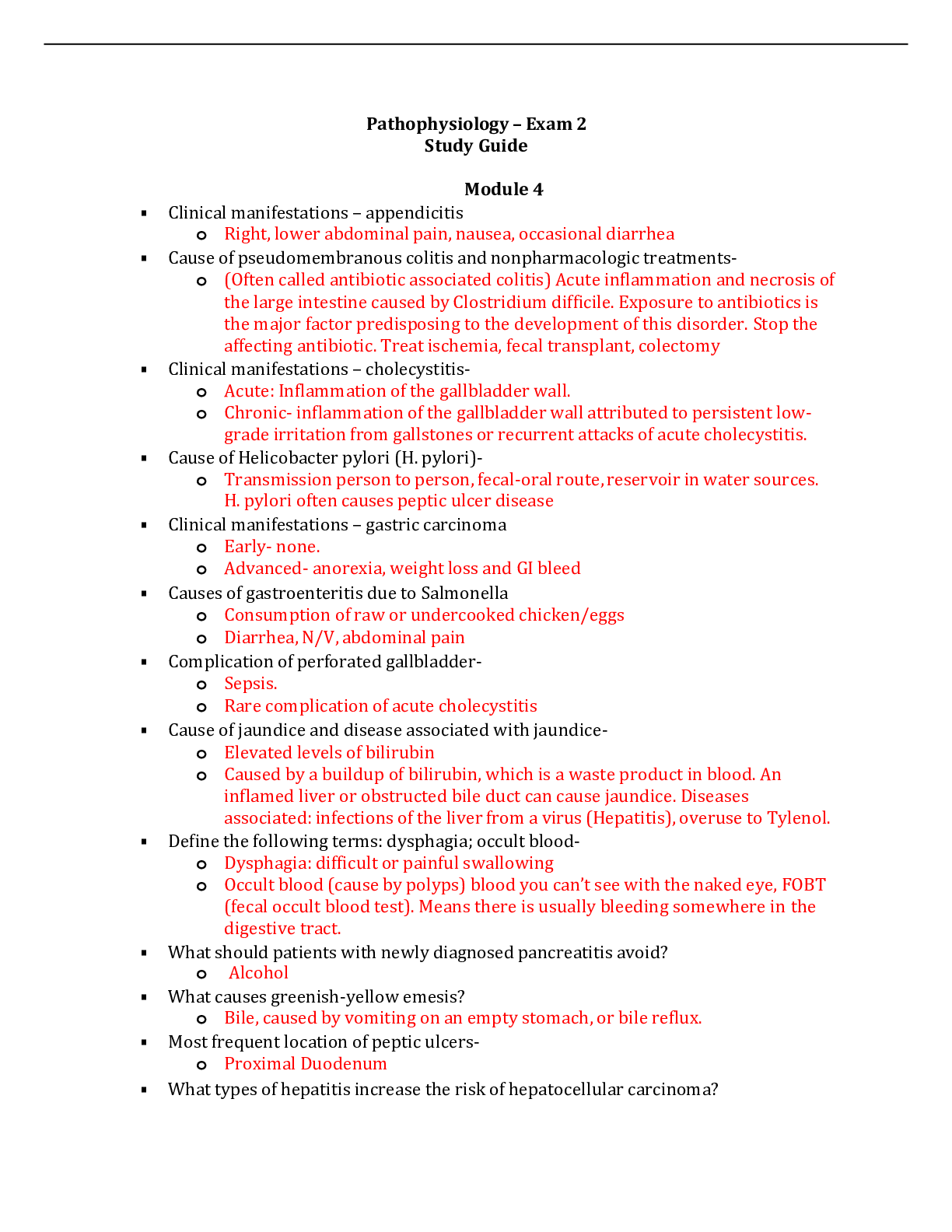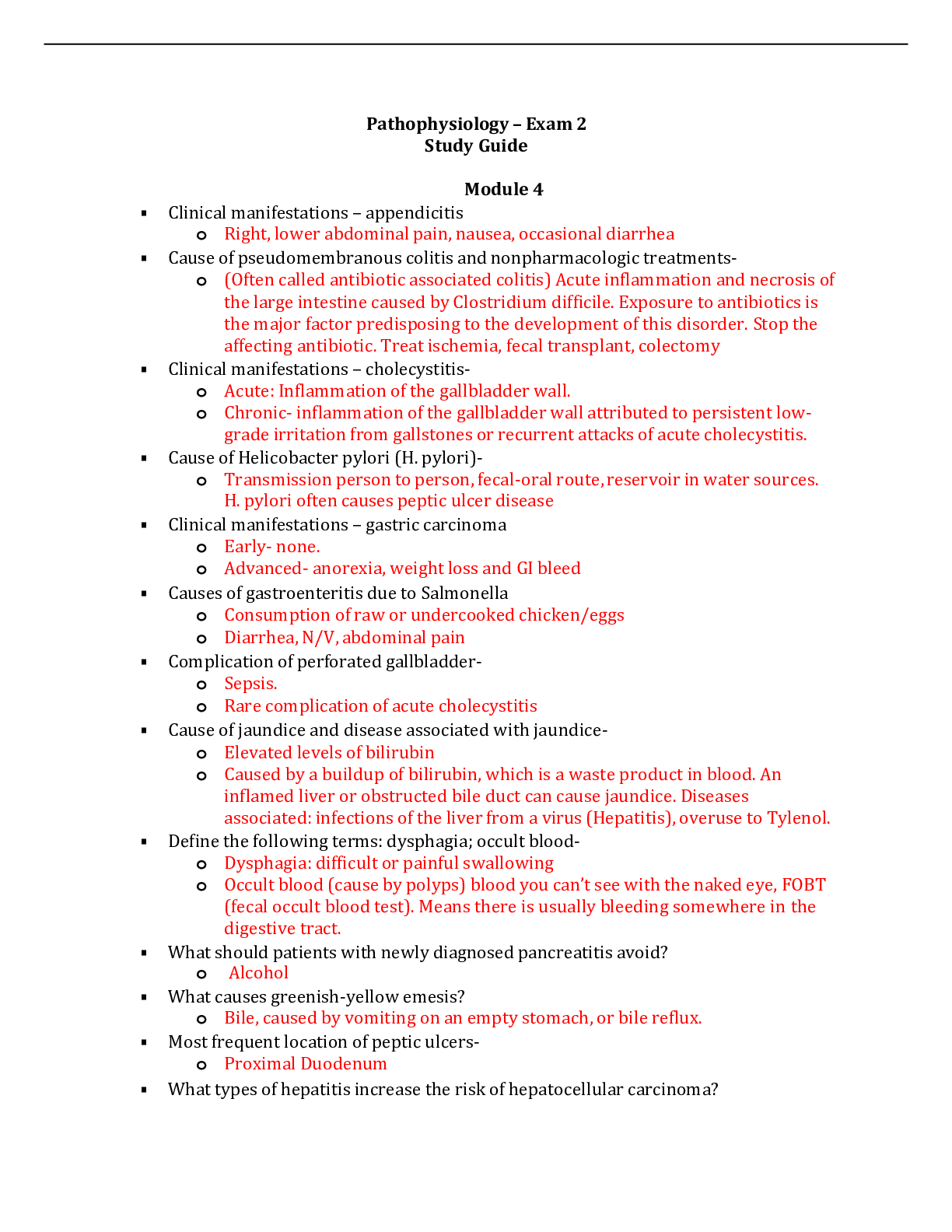Clinical manifestations – appendicitis
o Right, lower abdominal pain, nausea, occasional diarrhea
▪ Cause of pseudomembranous colitis and nonpharmacologic treatments- o (Often called antibiotic associated colitis) Acute inflammation and necrosis of
the large intestine caused by Clostridium difficile. Exposure to antibiotics is
the major factor predisposing to the development of this disorder. Stop the
affecting antibiotic. Treat ischemia, fecal transplant, colectomy
▪ Clinical manifestations – cholecystitis- o Acute: Inflammation of the gallbladder wall.
o Chronic- inflammation of the gallbladder wall attributed to persistent lowgrade irritation from gallstones or recurrent attacks of acute cholecystitis.
▪ Cause of Helicobacter pylori (H. pylori)- o Transmission person to person, fecal-oral route, reservoir in water sources.
H. pylori often causes peptic ulcer disease
▪ Clinical manifestations – gastric carcinoma
o Early- none.
o Advanced- anorexia, weight loss and GI bleed
▪ Causes of gastroenteritis due to Salmonella
o Consumption of raw or undercooked chicken/eggs
o Diarrhea, N/V, abdominal pain
▪ Complication of perforated gallbladder- o Sepsis.
o Rare complication of acute cholecystitis
▪ Cause of jaundice and disease associated with jaundice- o Elevated levels of bilirubin
o Caused by a buildup of bilirubin, which is a waste product in blood. An
inflamed liver or obstructed bile duct can cause jaundice. Diseases
associated: infections of the liver from a virus (Hepatitis), overuse to Tylenol.
▪ Define the following terms: dysphagia; occult blood- o Dysphagia: difficult or painful swallowing
o Occult blood (cause by polyps) blood you can’t see with the naked eye, FOBT
(fecal occult blood test). Means there is usually bleeding somewhere in the
digestive tract.
▪ What should patients with newly diagnosed pancreatitis avoid?
o Alcohol
▪ What causes greenish-yellow emesis?
o Bile, caused by vomiting on an empty stomach, or bile reflux.
▪ Most frequent location of peptic ulcers- o Proximal Duodenum
▪ What types of hepatitis increase the risk of hepatocellular carcinoma?
o Hep B and C
▪ Clinical manifestations of chronic gastritis
o Upper abdominal pain
o Indigestion
o Bloating
o N/V
o Weight loss/loss of appetite
o Hematemesis may occur bc of damage to the gastric epithelial mucosa
▪ What types of things put a patient at risk for developing acute gastritis?
o Ingesting irritating substances- alcohol, aspirin, NSAIDs, viral bacteria,
autoimmune
▪ Clinical manifestations of acute gastritis- o Anorexia, nausea, vomiting, and postprandial (after meal) discomfort
▪ Causes of hiatal hernia- o Conditions where intraabdominal pressure increases: ascites, pregnancy,
obesity, chronic straining or coughing
o Loosening of the muscular band around esophageal and diaphragmatic
function
▪ What is the cause of a rigid abdomen in peritonitis?
o Peritonitis is inflammation of the peritoneum. Inflammation and abdominal
spasms
Read More


